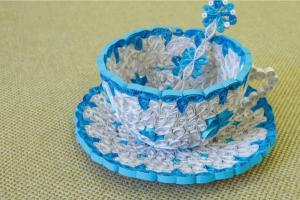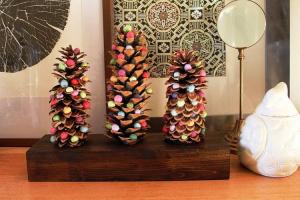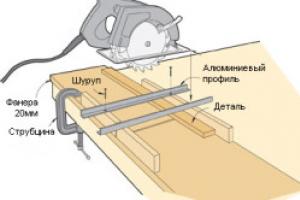Natural materials in last years are gaining more and more popularity in interior design. Wooden elements interior decor can serve as both an excellent addition to any interior and the basis for creating an original style.
One of these decorative elements are wood cuts that are used both in landscape architecture for paving walkways and as flooring in apartments and houses. Let's look at how to properly make a floor from wooden cuts in a residential area.
Pros and cons of floors made from saw cuts
 Any natural coating has a number of undeniable advantages over artificial ones.
Any natural coating has a number of undeniable advantages over artificial ones.
As for the coating from tree trunk cuts, the situation here is not entirely clear-cut.
Let's take a closer look at all the advantages and disadvantages of this design so that you can make the right choice.
Environmental friendliness
One of the main advantages of any natural material, which distinguishes it favorably from plastic, PVC or other polymer. Natural materials practically do not contain toxic components that could cause damage to the body. 
Wood in this sense is one of the most harmless materials that can be used in any living space - from the hallway to the children's bedroom.
Price
 Butt trimmings have a unique pattern
Butt trimmings have a unique pattern One of the undeniable advantages of this flooring option is the low cost of the source material. Indeed, butt trimmings can be collected almost free of charge at any sawmill or woodworking factory. At the same time, the cuts of the butts sometimes have a very intricate texture, giving the floor covering made from them a magnificent decorative look.
When we talk about low cost, we, of course, do not mean exclusive types of wood - ginkgo, ebony, wenge, etc. But quite affordable pine, birch, alder or larch can give interior give your living room or bedroom an irresistible look.
 True, the picture is somewhat spoiled by the additional components used in the construction of floors from tree trunk cuttings. These are, as a rule, epoxy varieties of self-leveling self-leveling floors.
True, the picture is somewhat spoiled by the additional components used in the construction of floors from tree trunk cuttings. These are, as a rule, epoxy varieties of self-leveling self-leveling floors.
Such compositions are among the most expensive flooring mixtures and are used to create floors with a 3D effect.
You can, of course, use cheaper options for fastening the cuts, for example, a mixture of clay and sawdust, but such floors will not be as durable in use, and the aesthetic effect in this case will not be the same.
If you consider coating made from wood cuttings to be a kind of “cheap and cheerful hand-made”, then you are deeply mistaken.
To create a truly magnificent floor from the end cuttings of tree trunks, you need to put in a lot of effort, money and time. I would like to say something special about the time spent on creating such a structure.
Installation speed
 It will take a lot of time to select and arrange the round dies in the correct order.
It will take a lot of time to select and arrange the round dies in the correct order. A covering made from wood cuttings cannot be called quickly installed. To lay a floor from wood cuts with your own hands, you need to have enough free time.
It will be needed literally for every stage of work: for preparing cuts of the required thickness, for laying and fixing them on the floor surface, for filling floors with epoxy mortar, therefore, if you are short of personal time, it is better to pay attention to another, faster option for installing flooring .
Aesthetic component
But if you still find enough time and finances to install high-quality floors in your apartment from cuttings of tree trunks, you will receive a floor covering that is unique in its aesthetic effect. Watch the video about this economical coating:
Glossy floors lined with wood “stumps” will look advantageous in combination with any elements of interior decor - from wooden wall panels and furniture to wallpaper with floral patterns.
Preparation of cuts
 Achieve the same thickness of cuts, otherwise the floor will be uneven
Achieve the same thickness of cuts, otherwise the floor will be uneven
You can prepare wood cuts of the required thickness with your own hands. To do this you will need a petrol or electric saw and a blank in the form of a tree trunk or trimming a tree butt.
Thick branches and trunks will also be used. thin trees. They can be used to fill the space between wood rounds large diameter. You can cut them at your dacha or garden plot.
 Such trimmings can also be ordered at the sawmill
Such trimmings can also be ordered at the sawmill All end cuts must be of the same thickness to avoid a situation with a traumatic “stump” sticking out above the general floor level.
If you do not have such an opportunity, then the necessary cuttings can be ordered for a certain amount by a worker at a sawmill or woodworking plant.
IN Lately decorative wooden cuts can be found on sale in some construction supermarkets.
When choosing the thickness of the cut, you should remember that this is the amount that will reduce the height of your room, so you should not make too thick cuts - the recommended thickness of wooden “pancakes” is about 3-5 cm.
 Hardwoods will last longer
Hardwoods will last longer Thinner cuts are extremely fragile and will inevitably be damaged during processing.
If there is a choice, when making cuts, preference should be given to harder wood species - larch, oak, walnut, hornbeam.
Of course, such wood is more expensive than pine, alder or birch, but the service life of the flooring will be longer.
The table shows the hardness classes of various tree species.

Wood for cutting should be taken well dried, since wooden rounds made from raw material may begin to crack after laying on the floor, and this will ruin the whole appearance your decorative floors. detailed instructions on making saw cuts is presented in this video:
It is not necessary to clear the bark from the trunks before sawing. This is usually done to remove the larvae of various woodworms that live under the bark. But in the case of filling the floors with a polymer composition, the larvae are unlikely to be able to survive, much less eat the soaked material. epoxy resin wood.
It is necessary to remove the bark if you are going to fill the gaps between cuts with clay mortar.
Processing of cuts
After required amount end cuts have been prepared, they should be treated with antiseptic material. This will prevent the development of fungus and mold on inner surface wooden rounds and inside them. To learn how to treat products with hot oil, watch this useful video:
If, according to the design, the wooden surface of the cuts will not be covered from above self-leveling floors, it would not be superfluous to treat it with impregnations against wood-boring insects and fire retardants to reduce the likelihood of fire.
Preparing the subfloor
 We remove the bumps from the old base, seal the cracks, cover it with soil
We remove the bumps from the old base, seal the cracks, cover it with soil
The next step is to prepare the rough subfloor and lay the cuts. The surface of the base should be almost perfectly flat, without holes or bumps. Otherwise it will be difficult to achieve perfect flat surface decorative covering.
By using building level, smooth metal profile or wooden slats We check the entire surface of the floors. We remove the bumps in the right places grinder or a mason's pick, and fill the holes with plaster mortar.
 If the rough base is too uneven, it will be easier to pour a leveling screed over its entire area.
If the rough base is too uneven, it will be easier to pour a leveling screed over its entire area.
To protect wood from moisture contained in concrete floors, floors are covered with rolls waterproofing materials or coated with water-repellent mastic.
Laying slices is the main part of the work on installing decorative floors, similar to laying out a mosaic. Several installation technologies are available wood slices onto the prepared surface. 
Filled with self-leveling mixtures
 First, lay out the largest sections
First, lay out the largest sections This option is best suited for creating noble floor coverings for apartments or country houses.
Sawed round pieces are laid out over the entire floor area. It is better to start the layout with the largest cuts, leaving space between them for smaller elements.
 After this, we fill the gaps with small cuts, which allows us to diversify the overall picture and save on the consumption of such expensive material as self-leveling floors.
After this, we fill the gaps with small cuts, which allows us to diversify the overall picture and save on the consumption of such expensive material as self-leveling floors.
The rounds can be laid directly on the waterproofing without additional attachment: after pouring with epoxy mortar, all elements will be soldered into a single monolith.
After completing the layout of the end cuts, we begin to fill the floors with an epoxy self-leveling mixture.
For more decorative effect You should choose not completely transparent, but slightly darkened epoxy self-leveling floors.
 Spread the mixture with a wide mop
Spread the mixture with a wide mop We dilute the mixture in accordance with the instructions and pour it over the “stumps” so that they are slightly closed (by 0.3 - 0.5 cm).
Since self-leveling floors have increased fluidity, leveling them will not cause you any particular difficulties. To do this, just use a wide construction mop.
Laying on sand
If the thickness of the wooden “pancakes” you have is different, then for ease of leveling you can use coarse sand. The installation technology in this case is similar to the installation paving stones. A 2-3 cm layer of sand is poured onto the subfloors, and cuttings are laid on top of it. To learn how to beautifully lay alloys, watch this video:
Leveling them in height is done using a building level and rubber mallet, the blows of which deepen the protruding elements.
Filling joints with clay-lime paste
 This option is the most budget-friendly, since it practically does not use expensive purchased mixtures.
This option is the most budget-friendly, since it practically does not use expensive purchased mixtures.
In this case, the saw cuts are laid on a layer of plywood, to which they are glued using glue (PVA, “liquid nails”, etc.).
Then we prepare a solution consisting of 5 parts of sawdust, 2 - clay, 1 - lime and 1 - melted fat or vegetable oil. We fill all the gaps between the “pancakes” with this mixture. As a final touch, we cover the surface of the cuts with stain and varnish.
What is not made from wood cuts. Garden paths, shelves, table tops, interior decoration and much more. Using saw cuts instead of floors in a living room is what our author decided to do.
Materials and tools
dry logs of different diameters;
a circular saw;
grinder;
liquid Nails:
tile grout;
polyurethane varnish for wood;
From dry logs of different diameters to circular saw I sawed round pieces of approximately the same thickness.

Using a sanding machine, sand each cut.
I prepared the base of the floor by removing the old covering. Found myself underneath concrete screed, which made it easier for the author to carry out further work.
Next, he lays the cuts as closely as possible to each other.


Empty space is filled with smaller cuts and twigs.

Having laid out the entire area with liquid nails secures each cut to the floor.

After waiting for the glue to dry, the author uses a sanding machine to level and sand the floor. The floor must be level and smooth.
Use tile grout to fill the gaps between the cuts.

After waiting for the grout to dry completely, I covered the floor with polyurethane wood varnish. I applied the varnish so that it got into all the cracks. Polyurethane varnish Apply in 3-4 layers. After the varnish has dried, the floor from the wood cuts is completely ready.
Just give a true designer free rein - he will decorate something like this! Someone chops wooden logs for firewood, and an interior designer brings them home, carefully saws them into thin plates and makes a wall or floor out of them.
Wood cuts look unusual and stylish in the interior of a house. Environmental friendliness, naturalness, unusual appearance - this is what attracts lovers of eco-style.

Design with wood cuts

No lining can compare in design with such wall decoration in country house. The forest-smelling wall will make you feel like a hermit, surrounded by centuries-old trees. Unusual design It’s quite easy to make walls, you just need to cut them from a tree trunk thin plates, then each “tile” is carefully attached to the wall with glue.
In this way, you can lay out the entire surface, circle by circle, or just part of the wall - in both cases, the effect will be amazing. The designers called this decor “an inverted wall” - it leaves the feeling that a woodpile of logs that have not yet been split has been laid in the room.
Of course, before decorating a wall with wood, it needs to be leveled; the cuts can be laid in any order - each tile will have a unique pattern, due to which the originality of the design is achieved.

Wood cuts in the interior

After attaching the saw cuts to the surface of the wall, it must be treated so as not to accidentally injure yourself due to the roughness of the wood and to avoid splinters. You can sand the surface, then cover it with stain or varnish. In addition, wooden saw cuts need to be treated with antifungal and insecticidal compounds.
This design is possible in a room decorated in the appropriate style, and the wooden cuts in the interior must be supported by at least a few more decorative elements, otherwise they will look alien. Properly selected materials for finishing the remaining walls, colors and furniture will create a harmony of space that emphasizes the unity of man and nature.

The use of wood cuts in the interior

Design with wood cuts

DIY room decor using wood cuts
Floor carpet made from wood cuts
If wooden slats can be placed on the wall, why not use them as a floor? This will take more time than decorating a wall, and more forest material will be needed.
To finish the floor, only tree trunks are taken, and the cuts should not be thin - the floor is larger than the wall, subject to loads, thin tiles will not withstand it. Instead of glue, a special solution is needed. The base needs to be leveled, the tiles from the saw cuts must be laid so that the surface is smooth.
The next step is to carefully sand the entire floor surface until it is perfectly smooth. Check the level during the laying of cuts and when sanding so that there are no unevenness or differences.
Just like walls made from saw cuts, the floor is treated with compounds that protect it from fungi and insects, then covered with several layers of varnish - you need to choose compounds for wood with a protective effect. The varnish will not only add shine and improve the appearance of the floor, but will also make it easier to clean.

Wood cuts in the interior

Apartment interior with wood cuts in the form of a tray
Furniture made from wooden saw cuts
IN in capable hands master, a piece of wood turns into... Yes, into anything:
- into the tabletop;
- into a chair;
- on a hanger;
- in the regiment.
All these pieces of home furniture can be made from wood cuts, you just need to choose a different diameter and thickness of the trunk from which the blanks will be cut.
For a small decorative table you need a wider log; the cut is not too thin. The table will turn out original if you leave the bark of the tree. The effect of naturalness and naturalness will be complete. Choose the legs to suit your taste, they can be metal or wooden, the table can be made very low and placed on it wooden tub with a flower, or higher - for magazines and newspapers. To protect against harmful bugs, treat the countertop with varnish with protective additives.

The use of wood cuts in the interior

Design with wood cuts

Room decor with DIY wood cuts in the form of a clock
Easy to do decorative shelf from a cut tree, sawing it off the trunk yourself or purchasing a ready-made one. From one round piece you will get two semicircular hanging shelves:
- cut a circle with a diameter of approximately 30 cm in half;
- take 2 corner fasteners for wall shelves, attach them with self-tapping screws first to the shelf and then to the wall.
All! The resin-smelling piece of furniture is ready.
Decorative elements from saw cuts in the interior
For those who create with their own hands, wooden cuts are an inexhaustible source of inspiration, a rich material for creativity. What can small and large wooden circles, sawn from a tree trunk or branch, turn into!

Wood cuts in the interior

Apartment interior with wood cuts
Panel from saw cuts
There are many options for making such decorative panels.
- You can place a thin cut cut in a baguette on a burlap or canvas base, complementing it with decorative elements.
- A panel of any shape, if desired, is laid out with thin plates cut from branches (as the creation of a wall was described above). Such a panel can be placed in an opening on the wall or framed in a baguette.
- The cut can be supplemented with a knot or snag unusual shape- in this case, you will get a three-dimensional composition of a unique design - it is impossible to find two identical snags or two saw cuts with the same pattern in nature.
- Small-diameter cuts from branches can themselves become the design of a baguette, photo frame, or composition made from natural materials. They are carefully laid out on the base, glued and varnished.
An interesting combination of two natural materials was invented by Ural craftsmen - on wooden cut finely ground stone chips are applied decorative pattern. The Ural land is rich in gems, and the most interesting compositions are created without adding paints - the colored eyes of the earth, as gems are called, are so bright and varied that no paints are needed.

The use of wood cuts in the interior

Design with wood cuts

DIY room decor using wood cuts
Decorating the house
You can use wood cuts to decorate ordinary objects in an unusual way, laying them out like a mosaic, for example, mirror frames, hangers, flower pots. To do this, take thin branches, from which you need to cut circles of the same thickness, but of different diameters. Glue, varnish - and a stylish piece of furniture will decorate your home.
Eco style kitchen
You can make hot coasters for the kitchen.
- The central round element is removed from a large-diameter round piece, it is filled with small-diameter saw cuts, all this is attached to each other and to the base, and the top is coated with varnish.
- More can be done simple design, but two-layer - for sawing larger diameter Several small ones are attached in a chaotic or specific order.
In the kitchen in rustic style Shelves decorated with twigs and saw cuts of small diameter would be appropriate. You can issue them kitchen apron, just pre-treat the wood with fire retardants. Cover the surface with varnish.

Wood cuts in the interior

Apartment interior with wood cuts
Unusual watch
You can make a clock for a rustic or eco-style home. The mechanism and hands are sold in craft supply stores; a ready-made saw cut can be purchased there, or a barrel of a suitable shape and design can be sawed. If you leave the bark on it, unusual item the decor will look even more original.
Drill a hole in the center and secure with front side hands, and on the back – a clock mechanism. You can paint the dial, or you don’t have to – this will make the watch look more stylish, just cover it with varnish to preserve it.
If, in addition to woodworking, you know the decoupage technique, you can combine these classes and decorate the surface using decoupage napkins or special decoupage cards:
- several elements that match the style of the interior are cut from a napkin;
- the elements are applied to the surface of the cleaned, sanded saw cut (to brighten the decor, you can cover it with acrylic primer);
- Using decoupage glue, the plot is glued to wooden surface, smoothed out so that there are no air bubbles left inside;
- the entire surface is covered with varnish - the more layers there are, the more spectacular the object will be.
In the same way, you can make kitchen stands, cutting boards, and decorative tabletops from wood cuts.

The use of wood cuts in the interior

Design with wood cuts

DIY room decor using wood cuts
Knick-knacks for the home
It seems that they have no functional purpose, but they please the eyes of everyone who enters the house, and if they were made by your own hands, then accept the compliments:
- Fridge magnets are a fashionable feature: a small saw cut is taken as a base, a magnetic tape is attached to it on one side, and the surface is decorated on the other using the technique of decoupage, leather applique, wood carving.
- Using an embroidery hoop, small cut circles and twine, you can create unusual panel. The basis can be linen, burlap, gray fabric or vintage canvas.
- Decorative wreaths are another fashionable interior item. Saw cuts are used as a decorative element, along with other natural materials– twigs, dried berries, flowers.

Wood cuts in the interior

Apartment interior with wood cuts in the form of a clock
Stylish, fashionable, unusual
Using wood cuts, you can lay out a composition on the wall, decorate a vase for flowers or fruits, make an unusual frame for embroidered picture or photographs. And how impressive the cover of a notebook or photo album, lined with small round pieces of wood, will look. There are many options for using saw cuts; human imagination is limitless, and there is no need to stop it. Compose, create, admire the fruits of your labor!
Video: Panel made of timber - decorating the wall with your own hands
Decorating the walls of the house natural materials will never go out of style. The most popular option from natural materials is wood. However, many people have no idea what shapes wood can take if you approach the decorating process creatively. There are options that look much more original than standard boards or panels. For example, this could be finishing the walls with wood cuts, as in the photo in this article.
Design options
When it comes to such decor, many limit their imagination by imagining simple combinations of round parts obtained by sawing logs. These are the elements that are most often used in design. However, you can use elements of different thicknesses and sizes to create unique design surfaces.

In addition, you don’t have to decorate an entire wall with such details. It is enough to select one of its sections - such partial finishing of the wall with wood cuts will allow you to zone the room or highlight a certain area of the room visually.

Elements do not have to be round. There are other options - square, rectangular and oval. Depending on what details are used, you will get a different picture. In addition, square and rectangular parts are easier to assemble and connect to each other.

If you use different breeds wood or the color of the saw cuts, then you can assemble real paintings or a simple geometric mosaic. In this option, square and rectangular dies will look best, but you can also take round ones - it will also turn out interesting. If it is not possible to find ready-made parts of the desired color, they can be painted using stain or tint varnish.

Self-production of coating
If you do the finishing of the walls with wood cuts yourself, then its cost will be minimal. Finding a dried tree is not a problem, nor is cutting it into unique pancakes. They will need to remove the existing bark and, if necessary, sand the outside. The planes must be sanded in any case to avoid splinters and other similar injuries appearing on the hands.

In some cases, it is not necessary to free the resulting parts from the bark - if the decoration of the walls with wood cuts should look as original and natural as possible. In this case, all circles are varnished to avoid peeling of the bark. After everything necessary details will be prepared in the required quantity, all that remains is to secure them in the chosen place. There are several ways to do this:
- On vertically fixed slats or sheathing.
- Directly onto the wall surface using glue.
- Assemble a hanging composition.
The last option is used when it is intended to decorate only a small section of the wall. At the same time, among themselves individual fragments The composition must be carefully secured with glue or another type of fastening. You can use a plywood base to glue the individual components of the structure onto it, and then secure the resulting structure to the wall.
Fix the cuts to vertical plane easy with lathing. First, the sheathing itself is assembled, and all other decorative components are attached to it using glue, nails or another method. In this case, if necessary, the structure can be disassembled without any special consequences.
Finishing with wood cuts is carried out in the same way when fixing them directly to the walls, with the only difference being that the parts will be fixed without lathing and it will not need to be assembled. However, fixing the elements directly to the base with glue will not make it possible to easily remove everything, and the nails will remain a large number of holes.
Examples
Sometimes it is difficult to find a suitable design idea using a specific material. After all, not everyone has such a rich imagination and fantasy. Therefore, below are several photo examples of what wood trim can look like in different interiors and with different arrangements of this decor. At the same time, in some interiors only part of the wall is finished in this way, in others it is completely covered with wood, and sometimes the decoration is a hanging panel.
A garden plot is not only a place for growing potatoes, cucumbers and tomatoes, although I have no complaints about gardeners. But a beautiful exterior can interest any owner country house or a summer house, so the question of how to make wood cuts with your own hands may interest you.
Exterior design - beautiful garden paths
Stages of constructing garden paths from saw cuts
There is a lot of lumber that can be used to lay paths in the garden or in a flower garden near a country house, these are panels, boards, timber or terrace board(parquet), although it is not solid wood, but a composite - sawdust with plastic (wood plastic). But the most attractive material, of course, will be sections of logs, where the structure and growth rings are clearly visible. Below you will find step by step instructions for the production of fragments and their installation.

Harvested hemp
To implement such a plan, you will need a number of materials and tools, these are:
- Lumber - logs for cutting into stumps.
- Waterproofing is thick polyethylene, but geotextile is better.
- Bulk building materials - pebbles, gravel (crushed stone), screenings, sand.
- Level – preferably one meter or more.
- Cutting tool – chainsaw.
- Auxiliary tools - rubber or wooden large mallet, buckets, bayonet and shovel, brushes.
Stage No. 1 – harvesting and processing of stumps

Harvesting stumps with a chainsaw
You should start the project by preparing the required amount of material, therefore, even before marking all the paths, you need to measure their total length and width in order to calculate the coverage area. This is very easy to do using the formula S=alength*bwidth, and then the average cut area S=π*r2, after which Stracks/Scut=xpieces - all that remains is to substitute the digital values. In order to find the average radius (r) of the cut, you need to measure the diameter (D) of the largest and smallest sections of the logs, fold them, and then divide them into two. We also divide the resulting diameter by two and get the average radius. For example, we take two diameters ø0.4+ø0.25=0.65 and divide by two: 0.65/2=0.325, which means Daverage=0.325 m, and radius r=0.325/2=0.1625 m, which means , S=πr2=3.14*0.162= 0.5024 m2 or roughly half a square.
For the manufacture of blanks, it is advisable to choose hard rocks wood that will last a relatively long time, for example:
- pine - 7 years;
- hornbeam – 10 years;
- oak – 10 years;
- larch – 25 years or more.

The bark must be removed
In addition to taking into account the type of wood, you need to pay attention to its condition, for example, large longitudinal cracks and/or damage by mold, rot, or beetles will not contribute in any way to increasing the service life. When you select suitable logs, cut them into logs of 15-20 cm, but it is advisable to stick to the same size (shorter stumps are poorly secured during installation). If desired, you can also sand the cuts, although this is not necessary.

Soaking the cut in antiseptic

The ends of the saw cuts can be painted in any color you like
When you have cut the required number of stumps, remove the bark from them - there may be various pests such as wood-boring beetles, bark beetles, shashel, etc. After cleaning, the wood should be protected from moisture and best drug in this case, it is boiled oil drying oil (natural, combined “Oxol”). But working with boiling water, especially with oil, is quite dangerous, so many people prefer various antiseptics to drying oil - they also resist rot well and protect against pests.

After drying, painted saw cuts are treated with mining or bitumen

The impregnation and paint must dry
After drying the drying oil or antiseptic (this may take up to 2 days), treat the lower part of the hemp with bitumen, as in the photo above. For this purpose, solid construction bitumen, commonly known as resin, packaged in bags, is best suited. The resin is broken into pieces and melted over a fire (bonfire) in a metal container. The treated part of the block will dry in a few hours, and the cut will be ready for installation. You can also soak the stumps in oil, but it won’t dry out and you’ll have to install them.
Stage No. 2 - marking garden paths

Marking garden paths
Now about the sizes. In the case where a garden path made from wood cuts, made by yourself, is designed for one person, then a width of 35-40 cm will be sufficient. But in order for two people to walk there hand in hand, the comfortable width will increase to 100-120 cm, although such parameters are very rare.
It is very important to determine the route of all paths that should connect all buildings and recreation areas (, etc.). Laying lines, as a rule, have turns, zigzags and roundings. To display them on the surface, metal or wooden pegs are driven into the ground, along which a nylon thread is pulled for reference. A similar operation is performed on the other side of the track, indicating its width.
Stage No. 3 - preparation of the base on the ground

Preparing the base on the ground
Now you need to cut the turf separately - it can be used for a plot in another place, but if you don’t need it, then, of course, you can simply dig it up. So, according to the guidelines marked with threads, we dig a trench half a bayonet deep, not counting the turf, but we also need to take into account the length of the stumps - you will understand this in the process of describing the working actions. Try to ensure that the sides of the groove are smooth and strictly vertical - this can be easily achieved with a bayonet shovel.

Laying waterproofing film
In order to protect wood from groundwater, the bottom of the dug trench is covered with waterproofing and it is best if it is geotextile. But how a budget option You can also use dense polyethylene, this is 150-200 microns (microns). If the seller does not know the thickness of the material, then you can focus on its suitability for the device and. When you plan to install a wooden border (stumps spread along logs, thick boards, stones, etc.), then the waterproofing should be wrapped on the walls of the trench or even a little higher (the excess will be cut off).
A cushion of sand mixed with gravel or crushed stone (can be screened without sand) with a height of 2.5 to 5 cm is poured on top of the waterproofing film and leveled as a rule. This layer will absorb water that gets between the logs to the bottom of the trench. So what does this give? Everything is simple and logical - moisture falls down under the influence of gravity, but does not linger at the base of the chocks, penetrates into the absorbent layer and after a while diverges to the sides into the ground, and some evaporates.
Stage No. 4 – installation of stump borders

Installation of stump borders
In this case, a border made of stumps was chosen, although you can edge the path with other material, the main thing is that it is combined with the cuts and the exterior as a whole. But if you still decide to do this with stumps, then choose the thinnest of the cut pieces, but it is advisable that they all be approximately the same diameter.
To make a border from the selected cuts, you need to tightly align them in a vertical position on each side of the trench, as shown in the top photo. Waterproofing on the wall will protect them from ground moisture, and the sand and crushed stone cushion from water accumulating during precipitation. The height of the block of wood above the ground after laying it should be about 3-4 cm.
Note. The border is not an essential accessory garden path from saw cuts at a dacha or country house. This element, so to speak, is voluntary.
Stage No. 5 – add another pillow

The second pillow consists of only sand
On top of the sand-crushed stone layer, another pillow of one sand 5-10 cm high is poured - the longer the hemp, the thinner the pillow. If you know what is under paving slabs and as it is done on the street, the real backfill is almost identical, only it is made from sand, and not from screenings and cement. Be sure to level the sand horizontally with a rule and level - this will make it easier to lay the cuts in the garden.
I want to make a small digression. The second pillow can be filled in before installing the border and then the edging will be at the same height as the rest of the stumps. There are no regulations or clear instructions here, since such sidewalks are not mentioned in any of the GOSTs or SNiPs, therefore, TU ( technical specifications), as such, do not exist here and everything depends on the imagination and desires of the installer.
Stage No. 6 – laying wood slices

You can leave gaps between the slices or fit them close to each other.
At this stage, you need to place all the cuttings in the dug trench so that they are 3-4 cm above the lawn. The order or arrangement of the logs does not matter at all - now the main thing is to create stability, and you can leave gaps between the cuts or adjust them close to each other.

Stumps are hammered into the sand with a rubber mallet
In order for the logs to stand tightly in relation to the surface, and their upper ends to be at the same level, the stumps are driven into the sand with a rubber or wooden mallet. In this case, it is better not to use a metalworker's (steel) hammer, since it will not only leave dents on the saw cut, but may also cause cracks. If you have nowhere to take a mallet, then, of course, use a hammer, just hammer the cuts through the spacer (a piece of board, bar or slats). Constantly level the surface of the installed fragments with a building level.
Stage No. 7 – the final stage of stump installation and path design

The space remaining between the stumps is filled with sand, screenings or fertile soil for grass
In any case, there will be space between the cuts of logs, even if you lay them very tightly - this is a feature of round timber. The cavities should be filled with bulk building materials such as sand, granite screenings or crushed stone, after which it must be compacted, otherwise it will sag under the influence of precipitation.

Design methods: 1) multi-colored ends; 2) grass between cuts; 3) coarse gravel between cuts
Let's move on to the final touch of the device from wood cuts, which we have already made with our own hands. The selection of photographs above shows three design options, although in reality there are many more, but it depends on your imagination.
The gaps between the stumps here can be filled with sand or granite screenings. But the highlight, as you can see, is the multi-colored ends of the cuts - water-repellent paints are used for this. This design of the path near the playground is just a gift for a child.
The second option involves low-growing () grass. To do this, after filling the cavity with sand or screening, leave 4-5 cm to the surface of the ends, tamp it down and fill the remaining volume with fertile soil mixed with seeds
Here, coarse gravel is poured between the stumps, as the distance allows. But in such cases, sometimes they go the other way - instead of gravel they fill in painted crushed stone, which looks very beautiful and original.
Below is a training video about installing a path from sawn logs:
Video: Caring for a garden path made from wood cuttings
A garden path made from wood cuts needs to be looked after, yes, exactly looked after, otherwise it can turn into a path that is laid through a swamp - trampled and dirty. Dirt will collect at the ends of the stumps, and it will appear there even if you very rarely use this route or don’t go there at all - there is always dust on the street. Therefore, sweep the garden paths with a brush at least once a month, and wash them if necessary. running water from a hose.
If pieces of dirt appear (even animals can leave it), it is better to use a scraper, that is, an ordinary metal spatula with a blade trimmed to 3-4 centimeters. Metal brush It is undesirable to use it, as it will spoil the texture of the cut.
Once a year or once every few years (depending on the intensity of movement around the garden), the saw cuts should be coated with an antiseptic or moisture-repellent paint. As a rule, these are acrylic or latex paint and varnish compositions for exterior work - they are more expensive than usual, but the service life is well worth the money spent.
Pros and cons

Original design: saw cuts, ornamental plants and painted crushed stone
Positive feedback from optimists:
- the construction of such paths is inexpensive;
- speed and ease of installation;
- no need to hire someone to do the job;
- looks natural;
- endless design possibilities;
- You can use used logs after dismantling any structures.








